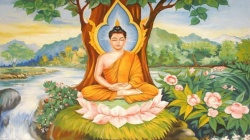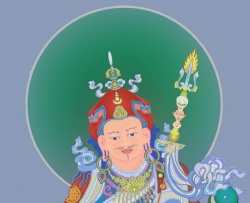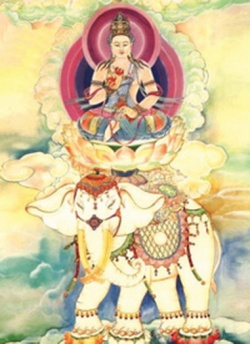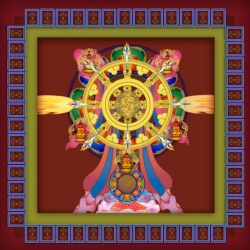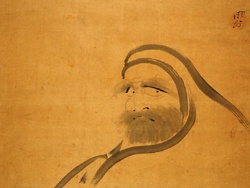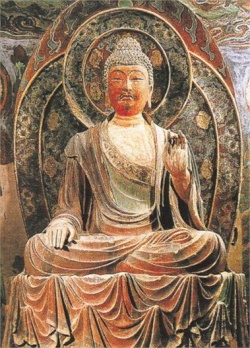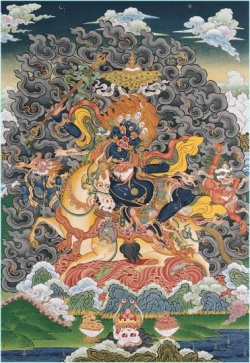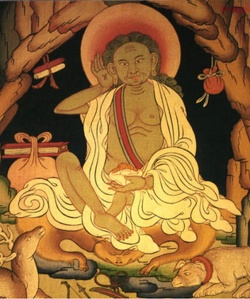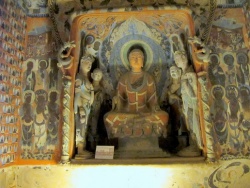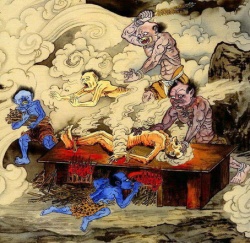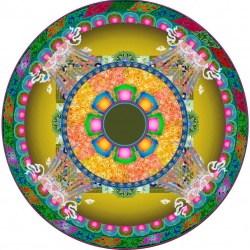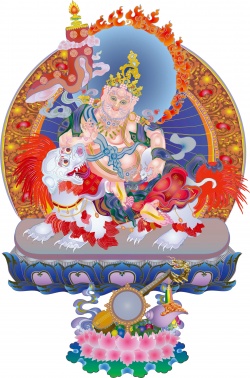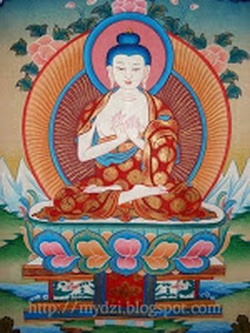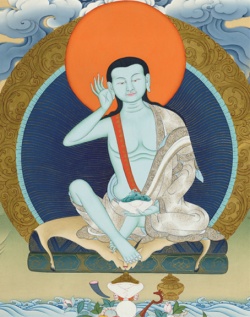Esoteric and Buddhism
A major misunderstanding has risen though the years in relation to the term ‘esoteric’. Esoteric means ‘the hidden side or Truth of phenomena and mentalities‘, ‘the knowledge of the Heart (spiritual intuition)’ as distinguished from the exoteric ‘knowledge of the mind – that what can be heard with the ear and read by the eye and reasoned about by the discursive mind.’ To the latter category belong all world religions in their outward forms (the inner often being lost), to the first category belongs Religion beyond religions. Esotericism is not ‘elitist’ in the common meaning of the word, but is only accessible for men and women who have reached a certain stage of spiritual evolution after many lifetimes of previous experience.
It does not merely come by our present personal wish, desire or decision, nor by following courses or associating with wiseacres. It comes by living the life of altruism only, lifetime after lifetime. Even the brightest scientific and religious minds may not be able to ponder it, or even recognize it, and may deny it. So if Theosophists speak of esoteric Buddhism, Christianity, books, teachings etc. they do not mean mentally ‘difficult’, ‘hidden’, ‘secret’ or ‘making use of occult methods’. They also don’t mean the Vajrayāna of Buddhism as it is often understood by the people.1 They refer to that inner wisdom that will be the common good of humanity at large in the future. Gautama the Buddha came some millennia ago to prepare the soil, and modern Theosophists and others play a role in that.
With ‘esoteric’ (derived the Greek esoterikos, pertaining to the inner) is meant the body of mystical and sacred teachings reserved for students of high and worthy character. It has nothing to do with great intellect and one’s degree of academic or other education. This body of teachings has been known and studied by highly evolved individuals in all ages. The esoteric doctrine is the common property of humankind, and it has always been so. In the various great religions and philosophies the world over the student can find fundamental principles which, when placed side by side and critically examined, are easily discovered to be identic for each system.
Every one of such fundamental principles is inherent in every great world religion or world philosophy; hence the aggregate of these world religions or world philosophies contains the entirety of the esoteric doctrine for those who ‘have the eyes to see,’ but usually expressed in exoteric form. The esoteric philosophy or doctrine has been held from time immemorial in the guardianship of great men, exalted seers and sages, who were born from time to time to promulgate it, or rather portions of it, to the world when justice is on the decline and the spiritual and intellectual need for so doing arises.
No one should think that in our ‘special’ days the esoteric doctrines can be had in full from The Theosophical Society or any other movement or organization. It was and is the task of this movement to recall to human consciousness at large that such doctrines do indeed exist, and lift a very small tip of the veil that keeps it hidden for the profane eye. A larger and larger tip of that veil will no doubt be lifted in centuries and millennia to come, if and when humanity shows worthy. This little bit alone has already shown able to make the established human belief systems shake on their bases.
The great exoteric religions all have been derived from the universal divine wisdom that always existed, and have been given to humanity by the true Esotericists who had not only Knowledge or ‘omniscience’ but, had in all their being become one experientially with the true teachings concerning the universe. However, none of these world religions or philosophies gives in clear and explicit form the entirety of the body of teachings which are at its heart. Some religions emphasize one or more of such fundamental principles, while others will emphasize on some other; in either case others of the principles remaining in the background.
This readily accounts for the fact that the various world religions and world philosophies vary among themselves and often, to the unreflecting mind, superficially seem to have little in common, and perhaps even to be contradictory. The cause of this is the varying manner in which each such religion or philosophy has been given to the world, the form that each took having been the best possible one for the period in which it was promulgated. Each such religion or philosophy, having its own place in the evolution of humankind according to the variety of cultures, represents the various human minds who have developed it or who, so to say, have translated it to the world in this or in that particular promulgation.
One example of such exoteric discrepancies – which are fully compatible if one understands the esoteric background from which they derive – is the existence of a Creator God in the Western religions (Judaism, Christianity, Islam) and the total denial of the existence of God and His Creation in Buddhism and Jainism, for example.
Esoterically there is definitely no ‘person-like’ God who is limited as to space and time and who could be found on any specific location in the universe. Esotericism clearly denies the existence of anything ‘external’ in the universe, the universe being One Being which manifests itself to limited consciousnesses in many facets. Every principle in the cosmos, such a Mind, Desire, Matter (=density of substance in various degrees), Wisdom, Energy and Divine Essence (from which and in which all manifested phenomena exist temporarily) are but modifications of One Being, Consciousness, Life that ever moves and changes for the eye of all things that change (māyā).
The divine is as present in a grain of sand, a galaxy, an atom or a man, and all these beings are continuously conscious in various and varying degrees, living and changing due to cosmic Mind – and this is what the world knows as Creation as well as Evolution. The eternal Mind can not conceive of a beginning or an end or anything that is ‘less’ than eternal. But within this eternity creation and destruction take place continuously in whatever time-limit small or big one wishes to fancy, and beyond. Inherent Cosmic Mind is the great changer, manifestor, creator.
Therefore Divine Creation, consisting of the activity of all conscious more or less perfect divine minds, takes place continuously, and one may call the togetherness of all lofty spiritual intelligence ‘God the Creator’ if one wishes to do so. This exoteric idea of God as propagated in Judaism, Islam and Christianity etc. has the power to bring forth great respect in the human mind, so it can feel and partly understand why beauty, goodness and intelligence are all-pervading in Nature. Exoterically, this one God-idea taken on its own fails to explain the obvious existence of evil, suffering and failure in Nature, and thereto other teachings had to be given.
Systems that were given to more philosophically minded and spiritually developed people could make a further step by straightaway denying any limited true existence in the cosmos in the form of a God or Being that is finite. Creation then becomes an eternal process without beginning or end, though it may show periods of relative activity and withdrawal from activity, and periodic movement up and down from spiritual and material (i.e. manifested in its ultimate sense) and spiritual phases again.
Another such discrepancy exists between Jainism (which is at least partly pre-Gautama Buddhism) and Buddhism, where the first claims, while the second denies the existence of an eternal individual soul. The first is the more obvious from a mental point of view, the second is the more philosophical from a spiritual point of view, and is therefore much more difficult to understand by average people.
The fact that no religion gives out the full Truth is because it can not yet be understood by humankind at large at a particular time – and as a proof of this we see the tremendous suffering people have brought and bring on each other in the name of ‘God’ or ‘Religion.’ Many of these quarrels find their basis in mental interpretations which are of a lower, or rather a less perfect nature than in direct perception of Truth – and it is from this direct perception which itself is beyond interpretation that all interpretations derive.
The religion of Hinduism however much it has been ‘exotericized’ by the Indians – contains both the idea of Eternal Brahm(an), i.e. the All, and Parabrahm(an), i.e. that what is eternally beyond Brahman, and at the same time it teaches us of cyclic Creation by Brahmā, exoterically one creator-god but in reality the collectivity of creative minds in the universe. Hinduism preaches the existence of an individual soul for each and every being, but also the oneness of them in Brahman. It teaches change and constancy, duality as well as non-duality.
Very much of esoteric truth lies hidden within the ancient and even later Hindu scriptures, but one needs keys to unlock these truths. Without these keys being available for the masses, Hinduism has become greatly a body of polytheistic idolatry and often selfishness (each one seeking his or her own god without concern for others).
True Esotericists, initiates, kevalis, bodhisattva’s etc. were and are highly evolved humans and are beyond mental mistake and speculation. In a number of cases they came as prophets, messiahs or avatāras, using an appropriate human-embodied being as intermediate instrument for communication between the divine and the human realms.
The term esoteric is applied to the advanced instructions given to qualified candidates in Mysteries, i.e. true schools of Philosophy. Jesus in the Bible, for example, referred to teachings for his disciples in private, but veiled for the public, precisely as all other ancient religious and philosophical teachers always had. Esoteric teachings both were and are such as could not be understood or profitably received by those not previously prepared by study and probation by a true teacher. Exoteric or outer teachings however were often given to the world in symbolic language which revealed the esoteric meaning only to those who were in possession of the keys to interpretation. The esoteric tradition has existed and will continue to exist on various and successive levels until the end of human development, i.e. many millions of years in the future.
If the word ‘esoteric’ is used in modern worldly articles or books this is a by definition a degradation of the term.
The great Tibetan philosopher, scholar and reformer Je Tsong-kha-pa (1357–1419) is, by Tibetans and Theosophist alike, generally regarded as the reformer of Tibetan Buddhism of that age as well as the reformer of esoteric Buddhism. He is also the one who, though he himself has never been outside Tibet, is said to have taken the compassionate initiative to send a ‘messenger’ to the western world in the last quarter of each (European) century to make an effort to introduce them into the eternal values of inner Buddhism or Esotericism. The foundation of the Theosophical Society then is one of such efforts.
Tsong-kha-pa studied the Buddha’s teachings of all Tibetan Buddhist schools of his time – all of which were less or more in decline, and received initiations and transmissions in all the major schools.
His main source of inspiration however became the Kadampa tradition, which goes back on Atiśa.
Based on Tsongkhapa’s teaching, the two distinguishing characteristics of the Gelug tradition1 are the union of Sūtra2 and Tantra,3 and the emphasis on the step by step graduated way to enlightenment along the three principal aspects of the path: 1) a genuine wish for liberation from illusionary and cyclic existence, 2) generation of bodhicitta and 3) insight into emptiness (Śunyatā).
Atisha’s Lam rim inspired Tsongkhapa’s Lam Rim Chen Mo4 which became a main text among his followers. He also practiced and extensively taught the Vajrayāna or Diamond Vehicle, and especially how to bring the Sūtra and Tantra teachings together. For that purpose he wrote works that summarized the root teachings of the Buddhist philosophical schools, as well as commentaries on, among other works, the Prajnāpāramitā literature and Chandrakirti’s Mādhyamakāvatara.
Tsong-kha-pa is thus known to have thoroughly studied and practiced the teaching of the extant Buddhist schools of his time, notably the Sakya-pa, Kagyu-pa and Kadam-pa and Nyingma-pa traditions.
In a hymn dedicated to him we read:
When the teachings of the Sakya, Kagyue, Kadam
And Nyingma sects in Tibet were declining,
You, O Tsong Khapa, revived Buddha’s Doctrine,
Hence I sing this praise to you of Ganden Mountain.
- From: Robert Thurman, Life & Teachings of Tsongkhapa, p. 243
Furthermore, he promoted the study of logic, encouraged formal debates as part of Dharma studies – which today is still a daily practice among school students at monastery schools and scholars – and instructed disciples in the Guhyasamāja, Kālachakra 5)and Hevajra Tantras.
Tsong-kha-pa considered the Esoteric Community to be the most important of the tantras and used the Ārya tradition as a template for interpreting all the other tantric traditions.6. The Guhyasamāja7 maṇḍala consists of thirty-two deities in all. (from Wikipedia: Tsongkhapa.) These are the five dhyāni-buddhas of the seven rounds of evolution over the Earth in Theosophy. Two dhyāni-buddhas are still to become active in this function in the future, because so far we are only witin the fifth root-race of the fourth Round and the future two are not directly mentioned in published Buddhist literature. They are the same five (+ two) who stand at the four directions and the center of the maṇḍala of the Bardo Thodol (known as Tibetan Book of the Dead, by Padmasambhava (8th Century).
The seven dhyāni-buddhas, also called the celestial buddhas or causal buddhas, through their emanated representatives each govern one round of the septenary cycles of evolution on a planetary chain. The seven dhyāni-bodhisattvas, or bodhisattvas of the celestial realms, similarly through their emanated representatives each govern one of the seven globes comprising a planetary chain. The manuṣya-buddhas are the buddhas which watch over the root-races in a round, two appearing in every race, one near the commencement and one near the midpoint of each root-race. Gautama Buddha was the second racial buddha of the fifth [our] root-race [of mental development).))
In his two main treatises (lam rim chen mo or Stages of the Path to Enlightenment and sngags rim chen mo or The Great Exposition of Secret Mantra) Tsong-kha-pa describes in meticulous detail how one should step by step and according to one’s intelligence follow the Sūtra path and the Tantra path.
Therefore, it is very clear that when Tsong-kha-pa refers to Vajrayana, tantra and mantra, he does not refer to the base practices of some Indian or Tibetan tāntrikas, but it was his merit to separate the chaff from the grain and thus remove such aberrations from true Buddhism and purify the latter while including existing values and methods and bring Buddhism back to its original state. Tsong-kha-pa even destroyed dangerous tantric works that were available in his time.
The coming of Tsong-kha-pa is said to have been foretold by the Buddha himself when he spoke of his coming as an emanation of the Bodhisattva Mañjuśrī in a verse from the Root Tantra of Manjushri (Jam-dpal rtsa-rgyud):
After I pass away
And my pure doctrine is absent,
You will appear as an ordinary being,
Performing the deeds of a Buddha
And establishing the Joyful Land, the great Protector,
In the Land of the Snows.[7]
When modern scholars and followers talk about esoteric Buddhism they usually refer to mantra, tantra and Vajrayana. Vajrayanists present a path within Mahāyana of which they claim that it leads to nirvāṇa in a very much shorter time than the mere Pāramitā or Perfection Path of Mahāyana, perhaps even in one life time. Modern Theosophists are of opinion that ‘there is no short way’8; in other words, those who do such promises delude the public9. However it is too easy to reject the tantra (or mantra or vajra) path on basis of this claim only. This claim is partly imaginary, because every human being has to learn everything that is to be learned within all levels within our universe to become a self-conscious god or dhyāni-chohan.
But one can, by moving away from lower mental action to higher and ever more subtle mental activity speed up the process. Is it necessary to choose the vajra path? Jesus stated for a very good reason, as quoted in Matthew 6:33, “But seek ye first the kingdom of God, and his righteousness; and all these things shall be added unto you,” ‘these things’ being the higher spiritual faculties and powers.Theosophy supports this point of view. Theosophy supports the Path of Perfection of pure ethics as it is propagated in Mahayana Buddhism, and supports the Path of Compassion beyond the arhat stage of Hinayana Buddhism (It means that Theosophy cherishes the idea of giving up one’s own benefit, including the fruit of highest enlightenment itself for any selfish purpose; thus a true Theosophist in the highest sense practices indefinite Patience, having lost the ability to choose for his own personal ego, because he unserstands that the personal, isolated ego which can profit without affecting the whole universe is but an illusion created by the mind, but has no true existence by itself.
One of the great practices of the Perfection Path is Patience that is sweet and be disturbed by nothing10 one develops the great compassion or bodhichitta: the true and irreversible desire to relieve all beings from suffering and illusion, to elevate all souls still chained to matter, and to avoid no difficulty for oneself in doing so if needed for this aim, even if the positive result is but meager or imperceptible. This reflects the spirit of the Buddha himself. This is how one becomes a Buddha of Compassion. It is the Great Vehicle or Mahāyana to Buddhahood. Then why need a still ‘higher path’ called Vajrayana or Diamond Vehicle? Some say that by following this path one can start to perform wise and compassionate action sooner, and thus help more living beings quickly. But what is the meaning of ‘soon’ and ‘quick’ in eternity? There will never be a time in eternity when greatness of soul and compassion are not needed to help in some place on some planet is some situation somewhere. Compassion is the Law of laws.
Moreover it is easy to tell oneself that one is ready for the higher and quicker path, whereas deep, below or beyond one’s daily consciousness there is still a selfish motivation. This will then inevitably lead to the disciples ‘fall,’ because the existence of even the slightest selfishness is based in a belief that a Self or independent ego truly exists. This is contradictory to the core teaching of Buddhism and Theosophy known as ‘Emptiness’ or ‘Zeroness.’ In realizing emptiness (śunyatā) any illusion of egoness or true existence of phenomena on themselves disappears for ever. No thing that we call ‘true’ in our world is really true from the viewpoint of a Buddha.
The true Vajrayāna path can therefore only be entered when emptiness has been realized and unselfishness alone remains within the disciple or chela. Then only can one enter the Path without risk. It is for those whose task or dharma lies there. The instructions on this Path are secret, even though apparently made public in modern books. They cannot be written down or transferred by words, and only a true Master or Mahātma or Bodhisattva can recognize the soul of such a pupil. Even then arduous tests are necessary ‘to test the purity of the gold in the fire.’
Every possible contamination must evaporate. Only when the disciple is truly ready the Path can be trodden. This Path may be quite different from what is now known to the world as Vajrayana. If Tsong-kha-pa was the true esotericist eulogized by Blavatsky, true esoteric Buddhism must be more than the methods described in Vajrayana. Perhaps it should be called ‘exoteric esotericisms’ The true esotericism is has hidden as ever. Paramitayana describes the spirit of the Buddha, Vajrayana makes use of visualizations of bodies of deities – all aspects of Buddha.
Also Vajrayana in its external teachings emphasizes on the steering of energies (prāṇas of the subtle (astral) body, which are but the lower two aspects of the human constitution, and therefore can lead to a certain subtilization the human bodies, which may lead to helpful siddhis or powers to be applied in the context of compassion. It can also rid the mind of its normal distractions and tendencies, thus leading it to ever greater power to distinguish even within very subtle thought-events, greater sharpness even within very subtle thought. Still then, there must be a higher path in which these subtle aspects of the mind are applied to penetrate still deeper, into the truly esoteric – and that is actually where the ‘Life’11 is entered – until it has become merged with buddhi, infallible non-dualistic Wisdom. Then, no more powers of a lower order are needed, or they can be created whenever they might be useful for some purpose of the bodhisattva.
It is known from the short history of the modern Theosophical Society that many aspired to and applied for chelaship at the feet of the Masters, but almost nobody proved as yet to have the stamina and purity of heart to enter the gate. It is also known that the few who did pass the preliminary tests before their own higher being and were ‘taken in,’ developed higher psychic and spiritual powers quickly and thus left every would-be fakir, yogi or psychic in the shadow. Such chelas (disciples) are helped to gain insights into the invisible and inner worlds of themselves and the Universe, and thus tremendously speed up their evolution and ability to practice Compassion effectively.
This path is really still for the very, very few in this period, but at the same time is as ‘old’ as eternity itself. This wisdom is were so many mythologies throughout history the world over refer to in hidden terms within their stories. It is also the reason why the modern Theosophical movement gave out teachings about things that for the worldly eye seem complete nonsense, impractical for daily life and at best attract curiosity – which if not satisfied quickly leads to disappointment. These teachings however are preparatory stages of inner teachings to be given to individuals and humanity in times to come.
Tsong-kha-pa himself has written about ‘How to train specifically in the Vajrayāna’ at the end of his work Lam Rin Chen Mo available as the three volume English translation called The Great Treatise on the Stages of the Path to Enlightenment by J.W.C. Cutler (Editor-in-Chief). His Summary and Conclusion (Chapter 27 of this work) is posted on this website as Lam Rin Chen Mo Chapter 27.
To be continued:
Esoteric and Buddhism part 3: Confusions about Buddhism and Theosophy
Gelugpa: Order of the Virtuous, also known as ‘Yellow Caps,’ founded by Tsong-kha-pa, and of which the successive Dalai Lamas are the Outer Heads. [↩]
In Buddhism, the sūtra refers mostly to canonical scriptures, many of which are regarded as records of the oral teachings of Gautama Buddha.
Buddhist Tantra is integrated into Vajrayana Buddhism
The Great Treatise on the Stages of the Path to Enlightenment – Lam Rim Chen Mo by The Lamrim Chenmo Translation Committee, Joshua W.C. Cutler (Editor-in-Chief). Snow Lion Publications, Ithaca, New York, Boulder Co, 3 Vols.
About Kalachakra, Wikipedia summarized what is knows to the world of it: “The Kālachakra Tantra [i.e the shorter version of it, because the much longer original is no longer exant – Ed.] is divided into five chapters.[3]:The first two chapters are considered the “ground Kālachakra.” The first chapter deals with what is called the “outer Kālachakra”—the physical world– and in particular the calculation system for the Kālachakra calendar, the birth and death of universes, our solar system and the workings of the elements; the second chapter deals with the “inner Kālachakra,” and concerns processes of human gestation and birth, etc. The chapters 3, 4 and 5 describe the “other” or “alternative Kālachakra,” and deal with the path and fruition.
The third chapter deals with the preparation for the meditation practices of the system: the initiations of Kālachakra. The fourth chapter explains the actual meditation practices themselves, both the meditation on the maṇḍala and its deities in the generation stage practices, and the perfection or completion stage practices of the Six Yogas. The fifth and final chapter describes the state of enlightenment that results from the practice. The phrase “as it is outside, so it is within the body” is often found in the Kālachakra tantra to emphasize the similarities and correspondence between human beings and the cosmos; this concept is the basis for Kālachakra astrology, but also for more profound connections and interdependence as taught in the Kālachakra literature.” (From Wikipedia
In the practice of the Ārya Tradition, the central deity of the Guhyasamāja is … a form of Akṣobhya, one of the five tathāgathas (pañcha tathāgata or five dhyāni Buddhas) who holds in his various hands a vajra – symbol of compassion, a bell – signifying wisdom – in his first two hands, and other hands hold the symbols of the four other dhyāni buddhas: Vairocana, Amitābha,
Ratnasambhava
and Amoghasiddhi
The Guhyasamāja Tantra (Sanskrit; Tantra of the Secret Community) is one of the most important scriptures of Esoteric Buddhism, (Vajrayāna), especially among the Gelukpas or ‘Yellow-caps’
See the small article Tantra
Somewhere in a modern Buddhist book I read that even Hitler would be purified of all his karma if he would continue to recite a particular mantra a set number of times. Isn’t that easy? –Ed.
“Kṣanti – Patience (forbearance, forgiveness) Sweet that Naught can Ruffle” – Voice of the Silence III) A very appropriate Chinese expression is that ‘the soft waters will ultimate erode the hardest rock.’
The Pāramitā path or the Path of Perfections which leads to the highest buddhic wisdom, the path of ethics, spiritual courage and meditation, contains all of the Buddha’s character. By practicing this one reaches Buddhahood. Perhaps through many lifetimes of meditation and experience including suffering, though the last seems no longer necessary ((According G. de Purucker in his Studies in Occult Philosophy, Chapter “Is it Necessary to Experience Evil?” every human has already passed through all forms of suffering and experience on the ‘downward arc’ of human development, which ended several millions of years ago. Since the deepest point had been reached, all possible suffering and experience of the spirit where it can possibly go through while descending into matter which is necessary to evoke Compassion has been left behind. We have now entered the upward half of the cycle, in which Spirit will withdraw matter back into itself.
